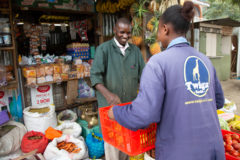For business people, crypto speculators, and the cousin who wants to send money back home, crypto versions of the US dollar are a lifesaver.
Africans are using stablecoins to make cross-border payments, take profits from crypto trades, and hedge against inflation ravaging the continent’s economies and individuals’ savings. Now new crypto-adjacent startups in the continent’s hot fintech space are racing to take advantage of the situation.
One of them, Uganda-born Eversend, is bundling fintech and stablecoin wallets to deepen its currency exchange offering.
Founded by Stone Atwine and Ronald Kasendwa in 2017, but with a public launch in 2019, Eversend is a near-super app for cross-border payments and crypto buying and selling. The company, which co-founder Atwine has described as Africa’s leading “FX startup”, also offers USD, euro and GBP wallets, and virtual cards. The startup is building APIs to power collections, payouts, and currency exchanges via stablecoins for other fintechs.
In 2020, sub-Saharan Africa received the equivalent of 2.5% of its gross domestic product (GDP), or $42 billion, from remittances, per World Bank data. But sending money to the region is expensive—the most expensive, in fact, compared to other regions globally. For context, if you had tried sending $200 towards the end of 2020, you would have spent an additional $16.40 (or 8.2%) to send it via legacy remittance channels. For African countries like Ghana, where remittances are the equivalent of 6.3% of the GDP, or even Lesotho where it is a full quarter of GDP, sending or receiving money into the country using traditional money transfer channels can be exorbitant.
Unlike these channels (banks and money transfer companies like WorldRemit, Moneygram or Wise), Eversend’s currency exchange platform leverages stablecoins to settle cross-border transfers.
Stablecoins: beloved by crypto bros, importers, and just about anyone concerned with inflation
Stablecoins are digital currencies pegged to other assets such as the US dollar or the euro—the idea being that their attachment to fiat currencies makes them less volatile than cryptocurrencies like Bitcoin or Ethereum.
Tether was the first stablecoin, launched in 2014, and it remains the model for those that have followed it. For every dollar deposited, users receive 1 token. The tokens can then, in theory, be exchanged back into the original currency at any time, at a one-to-one conversion rate.
Tether and most other dollar-pegged stablecoins (USDT) claim to have dollar reserves that correspond to the value of the tokens they issue, but it is difficult to prove this. For one, stablecoins are, at the core, controlled by private companies who operate like banks but without the oversight of a government central bank. Regardless of the allegations of being a scam, predictions of a stablecoin doomsday, and the spectacular crashes of algorithmic stablecoins, another branch of stablecoins that does not pretend to have real-life assets, stablecoins have continued to grow. Tether (USDT), the most popular of them all, reached a market capitalisation of $83 billion, but dropped to $73 billion in early May as stablecoins came under pressure following the general sell-off in crypto.
Last year, Chainanalysis, a blockchain data platform, reported that Africa received $105.6 billion worth of cryptocurrency—a 1,200% increase from the $8.8 billion of the previous year as crypto exploded across the continent. Stablecoins, a relatively new invention in the world of crypto, make up a significant proportion of these crypto transactions.
Africans use stablecoins for things as simple as saving or things as complex as financing business trips to Southeast Asia.
“Whenever I get paid at work, I just take out the money that I will be using for the month or 2 weeks. I just leave it in my account. Then whatever [money I have set aside for] savings I store it in a stablecoin,” Tochi Onyia, a blockchain researcher in Nigeria, tells TechCabal.
“Nobody wants to buy dollars and then keep the dollars in a bank account, ” said Uzochukwu Mbamalu, an entrepreneur whose dedicated stablecoin-enabled currency exchange, Palremit, is already in beta. He says that for young Nigerians, stablecoins offer the convenience of having a dollar account without going through the hassle of opening a domiciliary account, which requires two references who are currency account holders and regular KYC.
According to Mbamalu, business people looking to import goods from China, for example, buy USDT, exchange it on either P2P or over-the-counter traders for the Chinese yuan and use that to pay for their purchases. He explains that USDT and cryptocurrencies like bitcoin trade at a premium in China due to severe regulatory constraints.
“Most Chinese people do what they call an arbitrage,” he said. “They buy bitcoin in Nigeria and sell it in China. In fact, most business people and importers have an incentive to use USDT because if they convert their naira to USDT and then sell that USDT in China, they are going to get more value for their money. Sometimes they can get as much as 10%.”
Both Mbamalu and Eversend CEO Stone Atwine confirmed that most Africans hold USDT as a hedge against inflation.
A SWIFT for African stablecoins
For Africans who struggle to send or receive money across national borders, hedging against inflation is a secondary concern.
The bigger challenge is navigating the complex and often frustrating process of getting the dollars or euros required to purchase manufacturing input, agricultural produce, or finished goods in a neighbouring country.
Very often, because of how volatile African currencies tend to be, cross-border trade within the continent is settled in dollars. But dollars are scarce in Africa, usually controlled centrally, and tend to be more accessible by big corporations or the politically connected—less so to small and medium enterprises (SMEs). This state of affairs constrains these SMEs who need dollars, euros, or yen to settle trades but cannot easily access them.
While figures vary, intra-African trade reached an estimated $159 billion in 2018, according to the African Export-Import Bank (Afrexim). But researchers point out that informal and often cash-based cross-border trade in Africa is more dynamic, less understood, and is unreported by as much as 11% to 40%. Indeed, it is conceivable that informal trade could easily reach and maybe even surpass the value of deals that the trade fair could catalyse.
Why is all of this talk about trade important? Because intra-African trade is likely where the bulk of the unexplored value in simplifying cross-border payments in Africa lies. At least this is the value proposition of the recently launched Pan-African Payment and Settlement System (PAPSS).
PAPSS aims to make cross-border payments between participating countries and financial institutions seamless and near-instantaneous. In theory, PAPSS is a workaround for the impossibility of a single African currency. So far, 6 central banks, 3 switch operators, 18 commercial banks (most of which are Nigerian), and 5 payment gateways have joined the network.
If PAPSS gets a lot of users, it may become Africa’s SWIFT, the Belgian cooperative that handles most of the world’s settlements in international transactions. With the entry of PAPSS, people who buy and sell across borders in Africa now have 2 options for making payments: source for dollars, or use a PAPSS network service provider.
But firms like Eversend want to provide a third option, one that is similar to PAPSS or SWIFT but relies on global stablecoins, and in the future, privately issued blockchain versions of local currency for instant cross-border payments. “We’re building out this infrastructure that can help different businesses move value easily across borders. In the back we’re really powered by stablecoins,” Atwine explained.
Using global stablecoins like USDT is the low-hanging fruit, but it does not really remove the dominance of the dollar. On the other hand, building a SWIFT for local stablecoins is a moonshot project. Atwine has a point, though. If nothing else, using local stablecoins will at least reduce the demand for dollars and euros to make cross-border payments.
Governments join the fray
Atwine also said CBDCs or government-backed stablecoins are a potential cross-border payment solution, and he is on point. While they are not expressly built to facilitate cross-border payments, at least 9 African countries are researching or planning to launch CBDCs. Nigeria’s e-Naira is already live. It is the continent’s first CBDC and the ninth, globally.
But CBDCs are problematic because of concerns that they give the government near unfettered control over private money, especially in Africa where they have come on the back of—largely unsuccessful attempts—to ban crypto activity.
Beyond serving as financial inclusion ramps, as government spokespeople claim, some have suggested that African CBDCs can serve as local stablecoins for crypto exchanges.
CBDCs are a direct threat to both private stablecoins (where regulators only have to make sure they have adequate reserves the same way banks are regulated) and private banks (where actual stablecoin reserves can be deposited). As a result, even bankers are not impressed with CBDCs.
Atwine believes that while government-backed stablecoins a.k.a. CBDCs are a potential cross-border payment solution; the concerns about privacy and potential government overreach may dampen its adoption.
Using CBDCs or privately issued African stablecoins for cross-border trade is still in the future. For now, solutions like Eversend that leverage global stablecoins have the advantage of driving these payments. Their biggest challenge, however, will be convincing informal traders to ditch physical dollars for smartphone wallets.




















